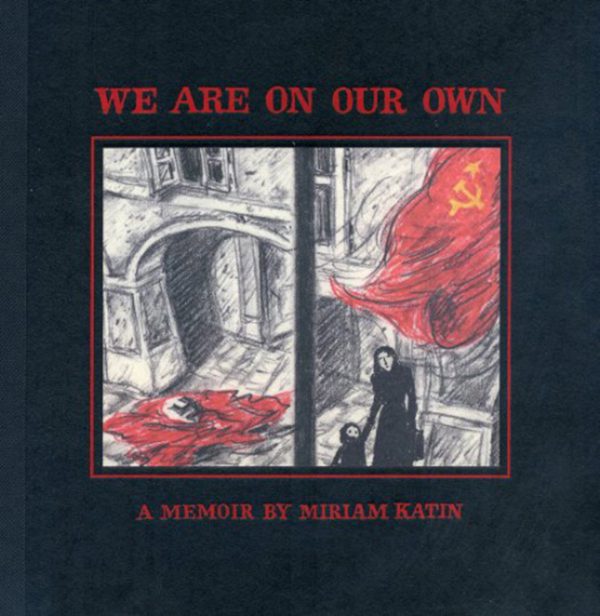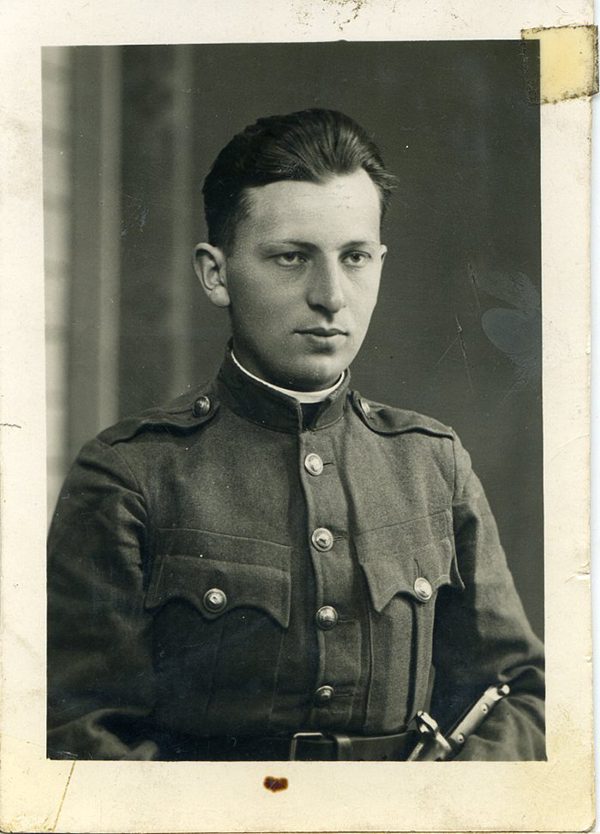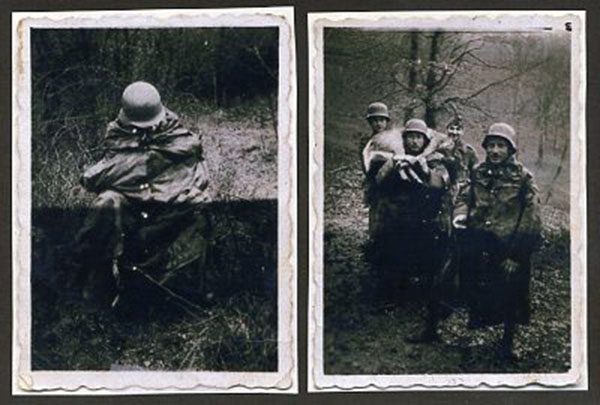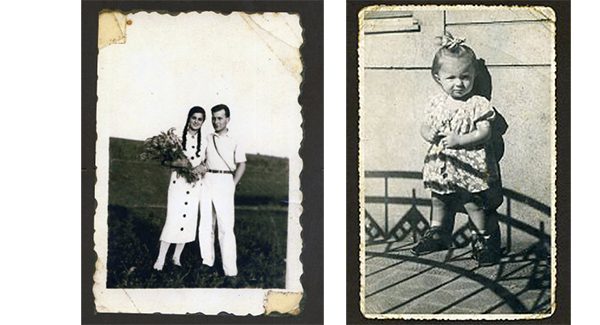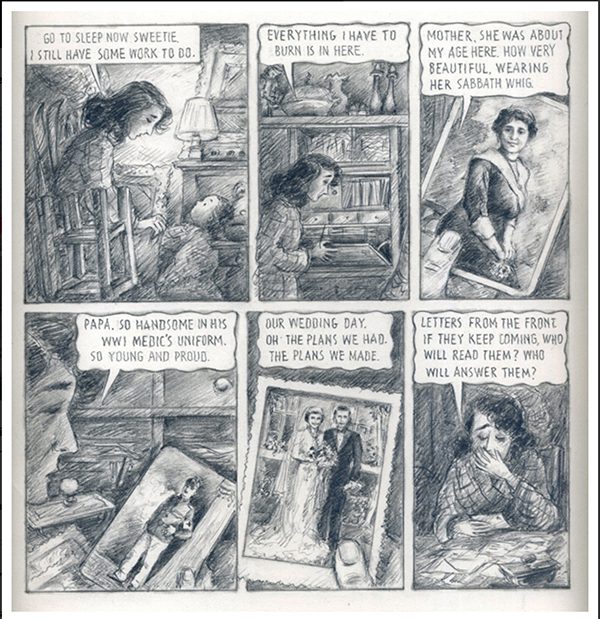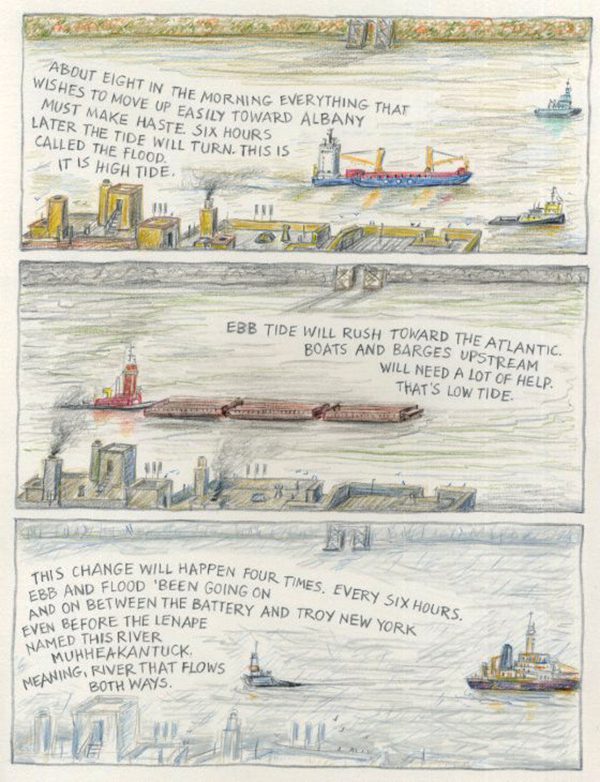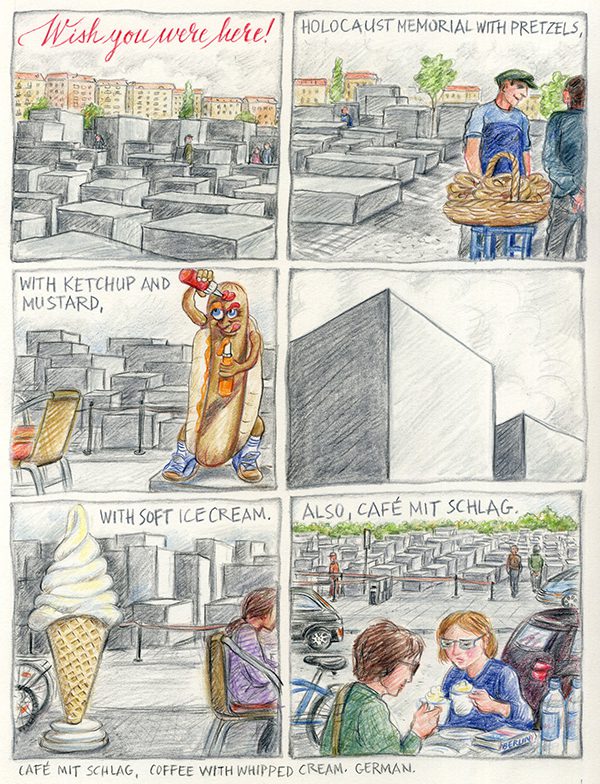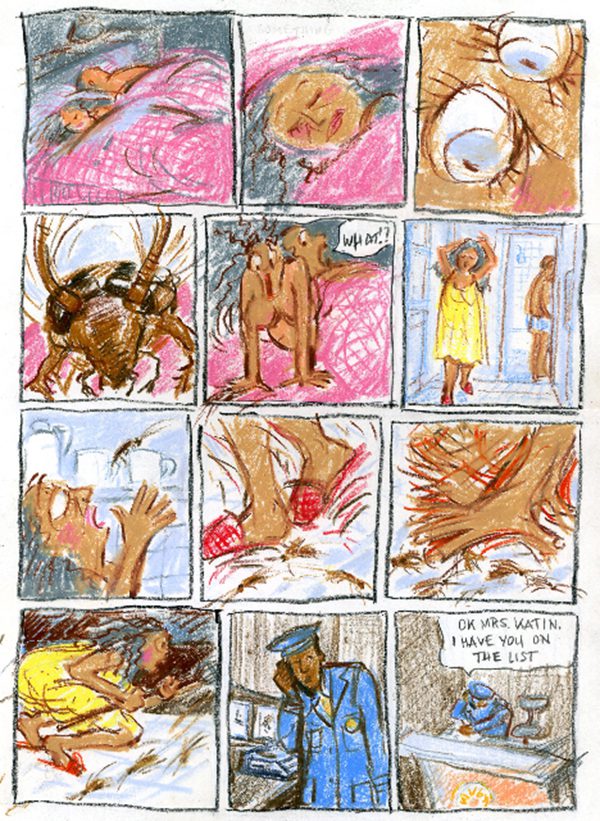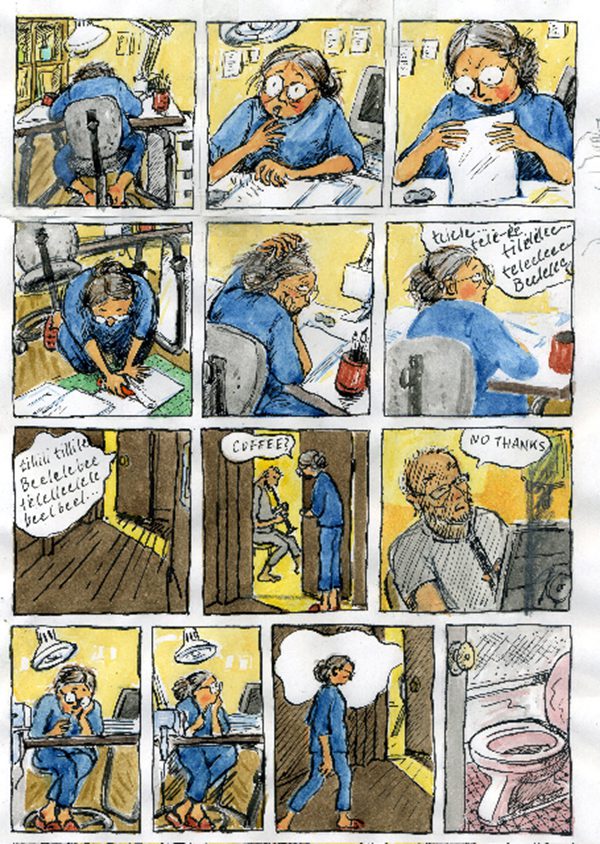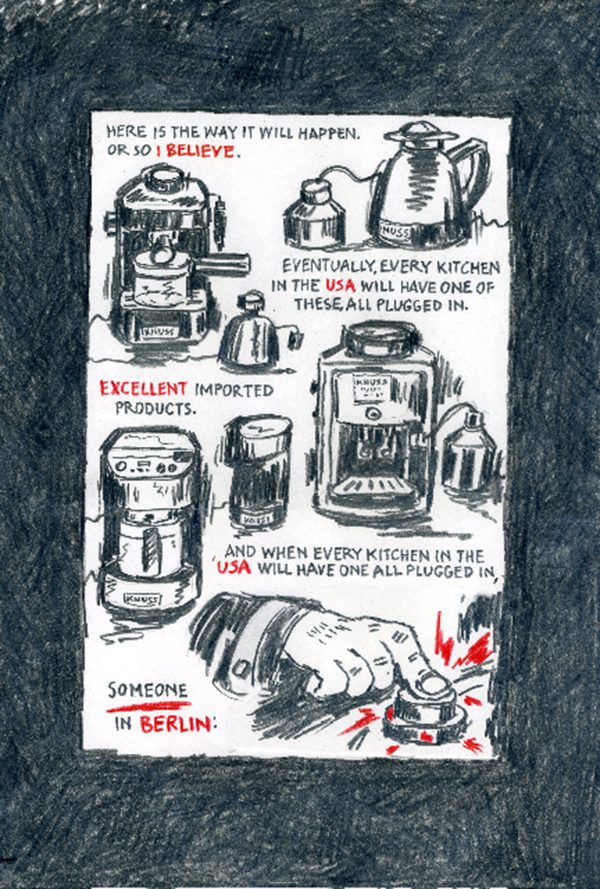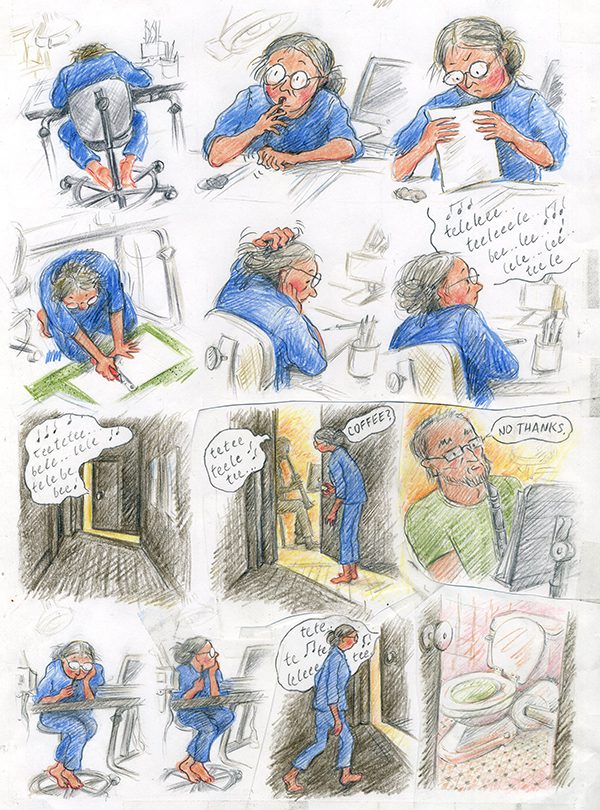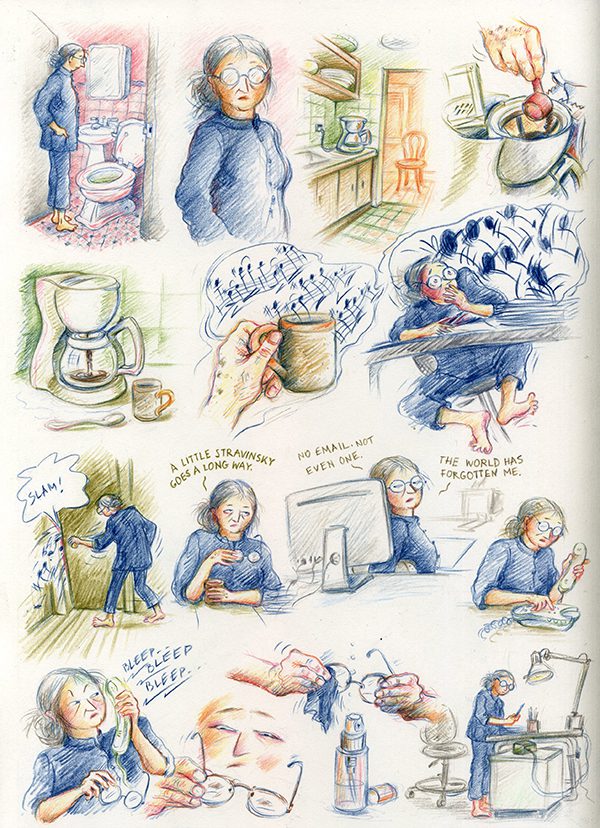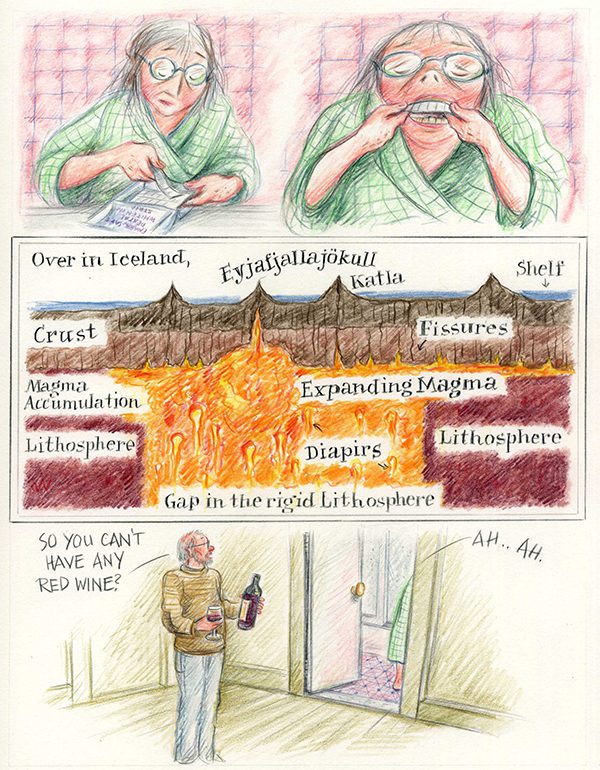The New York Comics & Picture-Story Symposium is a weekly forum for discussing the tradition and future of text/image work. Open to the public, it meets Monday nights at 7-9pm EST in New York City. Presentations vary weekly and include everything from historical topics and technical demonstrations to creators presenting their work. Check out upcoming meetings here.
Miriam Katin, the guest speaker last Monday, started by saying that her first graphic novel, We Are On Our Own had been difficult to make on account of its traumatic content, but also because it was her first attempt to tell a story in this format. A lot of planning had gone into the book and into translating a handful of childhood photographs, flashes of memory and her mother’s testimony into a book with a beginning middle, and end.
Katin was born during World War 2. When Nazis invaded her hometown of Budapest, her mother fled with Katin disguised as a peasant and her illegitimate child. They both spent the rest of the war hiding in the Hungarian countryside, separated from her father who was a soldier in the Hungarian army.
Katin’s father had to “spend most of his life in uniform fighting meaningless war,” but he had a passion for books that she shared.
These two photographs, one of her father wrapped tightly in his coat trying to keep dry, the other of a friend wrapping what seems to be dinner round his shoulder, have haunted her all her life and locked her memories of survival in a world of black and white. This was the color palette of We Are On Our Own. Using a filter of gray tones to represent a different time wasn’t necessarily a stylistic choice. On the contrary, she was clinging on to the only real insightful evidence she had left. She was representing the reality of her memories.
Katin showed another photograph in which a spiked iron rail overshadows her young self. She had always perceived this as an omen of the terrible things to come. She worked this image into her comics The Seven Sweet Spoonfuls of Understanding as means of gaining access into her young psyche.
Katin added that she did not want to depend on memory alone, no matter how strong it resonated. She stated it is part of the storyteller’s job to reinforce memories or events with facts. After the war had ended, care packages with cans of condensed milk were handed out to the population. In the process of incorporating the taste of the milk she loved into the story, she called up the manufacturing company to make sure the carnation she had remembered decorating the can was more than a figment of her imagination. She was cautious not to let her imagination overspill in attempt to balance a disproportionately heavy past.
However, as difficult as revisiting these memories had been, making Letting It Go, her second full-length graphic novel, was an even bigger challenge. She resolved to write this book in order to confront dramatic events as they were happening in real time. Katin described the process as “drawing her way out of an emotional storm.”
Throughout her presentation, Katin gave examples of how a close and obsessive study of detail enabled her to tell stories and wade through the pain. During the work on her first book, she was grasping at her own handful of distant childhood memories: certain foods, a little white dog, and the sounds of the bombing. She had to rely mostly on her imagination in order to sharpen narratives belonging to her mother.
However, in Letting It Go, she turned the spotlight on the musicality of her present life and was able to fully apply her passion for detail, mostly because she had access to it. If the stylistic choice of the first book had been the result of an inability to visualize the past beyond black and white, and a filter of terror and broken faith; then, the second book employed a more transparent style. Her emotions were unraveling directly onto the page, but streaming along side them were all the physical anchors of her focus.
The ability to gaze out of her apartment window onto the tides of the Washington River plays an important role in her struggle to cope with her anxiety. Her gaze could finally break away from the past, even though the content remained somewhat the same.
The book is drawn in full color, in excruciatingly honest detail and with expressive unfiltered lines. Her drawings are not even restrained by frames or a grid of any kind, excluding four or so pages depicting the war. Chronology is secondary to rhythm and musicality, and style is secondary to the urgency of laying marks on the page.
What replaced the grid in Letting It Go is the repetition of gesture, leitmotifs, and ironic juxtapositions simultaneously evoking laughter, sympathy and horror. To stay true to how the story depicts the wild unraveling of her own psyche, at no point does she mask or deny the reader of the gory details of her breakdowns and bodily functions. Furthermore, she goes to comically exaggerated lengths to magnify gruesome geological and zoological details, which have penetrated her world and her skin during that period. During the making of Letting It Go she fearlessly leaned over cockroach corpses, bed bugs, high rise balconies, airplane windows and volcanoes, in order to draw them with intense scientific precision. In this way, she overcame the initial jolts of paranoia as creatures and natural disasters invaded her peace of mind. A morbid curiosity compels her to override her fear and anxiety by bending in closer, and going to great lengths to weave them into her story and transform their threat into expression and rhythm.
In the prelude to the book, she is bewildered by the fact that the cockroach, which has entered her home is in fact called a German cockroach. On the subway, her curiosity is fueled by a quote from Kafka’s Metamorphosis. Wondering if this was a message for her, she even goes as far as to visit the American Museum of Natural History. However, her unhealthy obsession is quickly dismissed by a scientist who tells her that in Germany they’re probably called Polish Cockroaches.
In Berlin, this same gesture of leaning close into reality was not consistently fruitful.
Upon visiting the Holocaust Memorial in Berlin, she couldn’t see beyond the grotesque hot dog and ice cream sculptures and the food carts beckoning the tourists to gobble them up. The act of seeing ended up taking her by surprise. For instance, while she was walking with her husband in the Jewish Quarter in Berlin, they realized they were walking on bronze paddle stones engraved with the name of former Jewish tenants. The feelings stirred up through her body before they settled in her mind. In the same way, she drew the things she could see in the physical world before being able to arrive at the text.
Only by leading the reader into the drawings could she express her real fears, those which cannot be drawn. On an optimistic note, Katin exclaimed that her life is full of beauty and happiness. That is why she celebrates color through out the book, even when she is drawing bubbling magma, blood thirsty bed bugs, and monstrous sculptures.
This notion of color as redemption is beautifully depicted in a page with three strips of sunsets in Jersey giving “the hideous buildings by the bridge a rare moment of magnificence.” Although pain was bursting out of every pore, she was clinging on to her present surroundings as an anchor. And those were the tools she harnessed to wade out of the storm.
At this point, Katin unfolded a piece of paper and quoted the poet Kenneth Goldsmith: “the voice hydrates the written text.” Katin knew this would be her method. Comics is a direct medium for story telling, when you want to keep the text alive and honest. The drawings make the text and thought process transparent and alive.
It was only when she began to draw the river that she was able to move on from her procrastination routine of coffee, bathroom breaks, email, and studying her liver spots. She needed to lay down marks from the outside inward; from beyond her window, into her own private war.
Another example of an outside anchor point was a picture of an ugly air condition unit, partially obstructing the view from her window onto Washington Bridge. It is horrifying but bearable because hawks land on it. She uses the hawks as the end pages of Letting It Go. They are literally containing her story.
When she returns home from Berlin, she runs back to her beloved birds; the pigeons and the hawks circling her window. She enjoys their “conversations”: weird communication and abrupt and illogical decisions to suddenly take off and come back.
Letting It Go began while she was hard at work on another book. The war had long been over, both her and her parents had survived, but the violence had not ceased. It had always been bubbling up from within her. Katin described her childhood as spent taming her aggression. Luckily, she joked, a person is granted only so many years as a child, and her childhood was only as long as any other’s. But then, her own child suddenly announced to her he wanted to move to Berlin with his girlfriend. To this end, he asked her to help him become a Hungarian citizen as he was eligible for this through his ancestry.
For Katin, the thought of her son living in Berlin was inconceivable: “over my dead body!” she cries in the book, or it would be like “handing him over to the wolves!” But her husband, a musician who had studied in Salzburg and grew up admiring German culture, urges her to support her son’s decision. Her mother too, was quick to call her out on her stubbornness and reminded her that as a child, Katin had been just as restless to run about and not caring much about the ones she left behind.
Before drawing anything, she began to collect pieces of her life, napkins and souvenirs from bakeries and cafes, little notes on which she jotted down thoughts, cut up newspaper clippings and photographs. She stacked them on a wall in her house and hasn’t yet dared to take them down. Like before, when she studied the details of the few photographs in her possession in order to unlock the stories, these were the keys to extract a narrative, or at least a musicality she could express.
At first, when deciding on a medium for the book, she picked up crayons, which lent a rough and sketchy finish to her drawings, but then she decided to tame them in a second attempt. She confessed to losing patience almost immediately and abandoning the brushes and ink, which were too high maintenance and demanded a tight planning of the layout and a slower pace. Katin also rid the pages of panels and frames, in order to allow free reign to her emotions. Drawing the book in real time was important since the book’s initial purpose was to aid Katin in grappling with her anger and fear.
The very first page, long before any of the main story emerges, is a pure expression of the traumatic past haunting her everyday life. In the eyes of Katin, a fleet of unassuming yet overly efficient German coffee makers inhabiting almost every American household is in fact an ingenious distribution system of doomsday weapons susceptible to a simple trigger mechanism.
By directly focusing on the mundane, she allows for humor to enter the stage that adds a digestible layer of complexity to her anger and prejudice.
Katin said that one of her greatest inspirations for sequential storytelling was the two detectives Thompson and Thomson from Tintin by Hergé. By doubling their gestures and clothes in each frame, Hergé created a strong musical presence of their incompetence which he used to create layers of humor and suspense, and to pace the flow of his stories.
Many of the pages in Letting It Go employ this technique of repetition. She redraws herself again and again, allowing the musicality and the rhythm of recurrence to give a voice to her internal monologue.
The musicality is explicitly referenced throughout the book. Katin draws the notes pouring out of her husband’s clarinet and flooding the house. On the one hand, his music disturbs her concentration and offends her with its full-on Germanic associations. On the other hand, it aids her storytelling and mirrors the rhythms of her procrastinating and the pendulum swings that she experienced between agitation and acceptance. The musical notes block the corridors separating the rooms, echoing the emotional arrows and quivering lines of frustration, which surround Katin and isolate her from own family members.
Just as her husband always appears with a clarinet in hand, Katin’s tool for getting through the story is the cocktail shaker.
In the second half of the book, the notes by the notorious German composer, Richard Wagner, which she draws as the atmosphere of her house, become actual readable German words while her husband decides to take on the language. In a page following their return, her husband’s German banter merges with the surface of the river she has made; it breaks into colors and she’s enjoying drawing. She hurries to slam the door to his room, but at this point she has already softened up and is able to join in with her own German words, albeit profane ones. The compromises of her real life end up echoed in the drawing, or visa versa. The drawn German words are as articulate as the ripples in the water and contribute equally to the texture of the page.
The climax of the noise and tension filling up the page with texture is Katin’s story of how the eruption of an Icelandic volcano isolated Europe from the rest of the world and crushed her plans for victoriously returning to Berlin. Not long after she returns from her first traumatic visit to Berlin, a place she would have never in her wildest dreams thought to confront again, she is invited to exhibit her work at The Jewish Museum. The idea of being represented by her art in a place at the heart of her tormented nightmares flips her right around and she becomes obsessed with the idea of attending the reception in her favorite black suit and a fresh set of newly whitened teeth. Katin emphasizes this decision as being nothing short of an obsession. Her son, who had been the only reason Berlin had reentered her mind again after almost 60 years, informed her that he wouldn’t even be able attend the opening. Sure enough, the greatest obstacle standing in the way of her decision had been a physical obstacle, completely out of her control. It forced her to confront and question her own will to be there no matter what. Ultimately, she ends up peering over an old issue of a National Geographic and studying diagrams of volcanoes. In this way, she leads the reader into her story with humor and exciting visuals as she herself tries to make sense of her state of mind.
The cockroaches return to her kitchen throughout the book. The repetitive elements in her story work as a semantic grid. Only when she introduces the war into the story, do the images become contained by frames. These panels are missing the live rhythm of the events of her present. The images of a volcano bubbling up unbeknownst to her is also contained in a frame, up until the point in time where it finally affects her present reality and then it erupts through the panel.
Katin described how she was able to ease Germany back into her mind. For many years, Germany had only existed as a vague map of a country torn in half, surrounded by the cities that persecuted her family. She eases in through the everyday: a friendly, well designed German TV show, a Youtube instructional video for making German cocktails.
Finally, as she sits at the window on their flight to Berlin, she strains to focus on the mechanics of the wheels touching the ground. Here, she magnifies the details of her most anxious moments in order to lead the reader into to her story, just as she herself is able to walk away.
Although a bust of Lenin’s head, ominous street names, and giant memorials, remind her that she is not walking through just any old city, her first day in Berlin with her husband, son and his girlfriend seems to go quite smoothly. But later, her body that informs her otherwise.
Katin didn’t hesitate to expose the deeply intimate experience of soiling herself in bed with catastrophic diarrhea in the middle of the night. While her husband was still asleep she washed off her clothes and bed sheets, finally curling up in a fetal position in a drawing framed by train tracks. The realistic setting of the hotel bed becomes transformed into an image of loneliness and utter distortion, only after she drew the details of her physical undoing.
Katin explained it was important to her to deliver the details of that night. She was unashamed to draw the humiliating stains of the soiled sheets in detail and repetition spanning a number of pages. It was the only way to convey how powerful that night had been.
During the Q and A, Katin was asked about the events of the years after completing the work on Letting It Go. She answered that she often visits her son in Berlin and they have made a home for themselves there, at least in the way of their everyday lives. They return to the same apartment, they have a favorite supermarket, they go to their favorite restaurants and cafes and theaters. The ritual helps shield what cannot be completely resolved or sorted through.
There is a wordless sequence in the book, which repeats every time that Katin goes out to visit her mother. She stops to buy flowers, stops at the Kosher Deli, and waves back at her mother who always awaits at the window. The pages of their conversations are the most word heavy pages in the book because they show both the Hungarian and the English translation. Katin wanted to convey how their conversations differed from anything else and used the silent repetition of the ritual to lead the reader and herself outside of the flow and into a different time.
Images:
Image 1: Miriam Katin, We Are On Our Own, Drawn & Quarterly, 2006
Image 2-4: from Miriam Katin’s personal album
Image 5-6: Miriam Katin, We Are On Our Own, Drawn & Quarterly, 2006
Image 7: Miriam Katin, Letting It Go, Drawn & Quarterly, 2013
Image 8: from Miriam Katin’s personal album
Image 9-10: Miriam Katin, Letting It Go, Drawn & Quarterly, 2013
Image 11: from Miriam Katin’s personal album
Image 12-13: Sketches for Letting It Go
Image 13: Miriam Katin, Letting It Go, Drawn & Quarterly, 2013
Image 14: Herge, The Adventures of Tintin, Studios Herge
Image 15-19: Miriam Katin, Letting It Go, Drawn & Quarterly, 2013
About the author: Keren Katz is the illustrating half of the Katz Sisters duo. She is also the half that is not fictitious. Her latest book Uncontested Spaces is scheduled to be published by NO Press in 2013.
You can check out more of her projects here.

